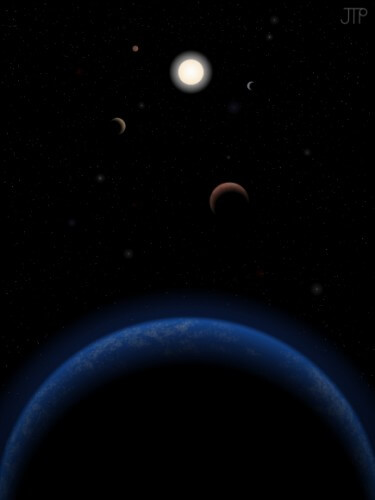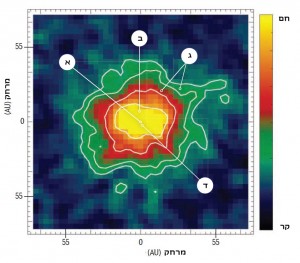A solar system discovered not far from us is similar to ours

The star Tau Ceti (Tau Ceti), twinkling at a distance of only 12 light years from Earth, is so similar to the Sun that it received countless references in science fiction stories and was the first star that astronomers looked for signs of intelligent life before the Jubilee. In 2012, Tau Seti became even more interesting when astronomers reported five possible planets, slightly larger than Earth, orbiting Earth closer than Mars orbits our Sun. One of these planets is in a zone defined as a habitable zone. Recent far-infrared photographs from the Herschel Space Telescope expand our understanding of the Tau Seti system and show fuller detail of its dust ring.
Dust is created in the solar system when asteroids and comets collide with each other, so it shows where these dust-producing objects, too small to be seen directly, orbit the star. In the case of Tao Seti, "it's a fairly wide ring of dust," says Samantha Lawler of the University of Victoria in British Columbia. As she and her team reported in November 2014, the inner edge of the belt is two to three astronomical units (AU) from the star, just like our Sun's asteroid ring. (An astronomical unit is the distance between the Earth and the Sun.) The dust ring of Tao Seti extends to a distance of up to 55 astronomical units from it. Here, at a slightly smaller distance from the Sun, is the far end of the Edgeworth-Kuiper belt, the region of small objects, the largest of which is apparently Pluto. The dust ring of Tau Ce, which appears to be full of asteroids and comets, certainly does not contain a planet as large as Jupiter, Lawler says. The gravity of such a massive planet would have ejected most of the small space rocks.
Within a year, we should receive from the new ALMA radio telescope array in Chile an even more detailed image of the ring, especially of its inner edge. The images from ALMA will help astronomers determine whether the five possible planets of Tao Seti actually exist. If there is an overlap between the ring and the estimated orbits of those planets, it is likely that they do not exist, since if they were there, they would eject most of the asteroids close to the star and remove the dust source.
But if the planets exist there, Lawler's team hypothesizes, then the system of Tao Seti is similar to what our solar system would have been if the four giant planets Jupiter, Saturn, Uranus and Neptune had not formed there: a system of small planets that are close to the star, and beyond them only asteroids , comets and dust.
A look at Tao Seti
Far-infrared imaging reveals Tao Seti's dust ring in unprecedented detail. The figure was published in the November 1, 2014 issue of the Monthly Notices of the Royal Astronomical Society.

A. Tao Ste. The star in the center of the image heats up the dust particles that orbit around it.
B. hot dust The hot dust emits long-wave infrared radiation that is picked up by the Herschel Space Telescope. The yellow color indicates the strongest radiation coming from the hottest dust particles, those whose orbit is closest to the star.
third. Cold waste. The red color indicates colder dust, and the green indicates the coldest and farthest from the star.
d. Planets. The five planets that may orbit Tao Seti are so close to it that their orbits are difficult to discern on a map of this scale.
The article was published with the permission of Scientific American Israel
